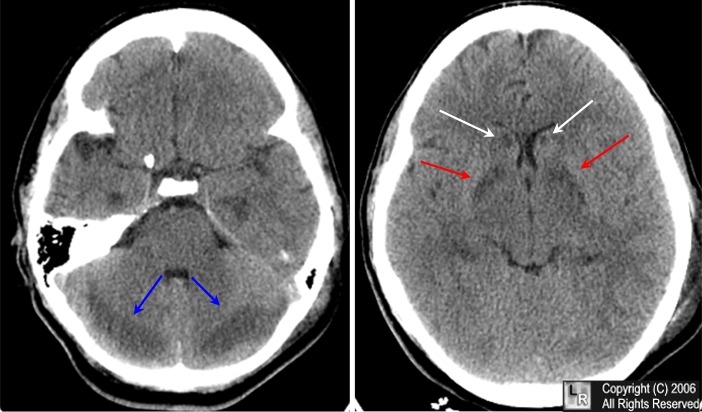
The Blood Brain Barrier (BBB):
The cerebral capillary is the site of the BBB. Interendothelial tight junctions impede the passage of electron-dense markers. Cerebral capillaries lack fenestrations and have tight junctions. They are active in the process of pinocytosis. All these features regulate the passage of highly polar hydrophilic molecules allowing virtually unrestricted passage of lipid-soluble substances. Cerebral capillaries have 2-4X the number of mitochondria as other capillaries. Cerebral capillaries have an array of important enzymes: ATPase, dehydrogenase, monamine oxidase, DOPA decarboxylase, acid and alkaline phosphatase, NAD and others. BBB has both central (cholinergic and aminergic) and peripheral (sympathetic and parasympathetic) innervation.
Areas without a BBB include:
The cerebral capillary is the site of the BBB. Interendothelial tight junctions impede the passage of electron-dense markers. Cerebral capillaries lack fenestrations and have tight junctions. They are active in the process of pinocytosis. All these features regulate the passage of highly polar hydrophilic molecules allowing virtually unrestricted passage of lipid-soluble substances. Cerebral capillaries have 2-4X the number of mitochondria as other capillaries. Cerebral capillaries have an array of important enzymes: ATPase, dehydrogenase, monamine oxidase, DOPA decarboxylase, acid and alkaline phosphatase, NAD and others. BBB has both central (cholinergic and aminergic) and peripheral (sympathetic and parasympathetic) innervation.
Areas without a BBB include:
-
choroid plexus
-
area postrema
-
median eminence
-
neurohypophysis
-
pineal body
-
subforniceal organ
-
commissural organ
-
supra-optic crest.
Carrier Mediated BBB Movement:
Glucose and aa's are actively transported as they are
not lipid soluble. These substances demonstrate stereospecifity,
competitive inhibition and saturation. May be bi- or unidirectional
transport. All aa's appear to use the same active transport system
(flooded in PKU, aminoaciduria's etc)
Evaluation of BBB function:
Using radio-isotopes or various exclusion dyes can
calculate from single pass what Km and Vmax are.
In humans BBB integrity determined by:
In humans BBB integrity determined by:
-
external detection of radionuclide activity with a sodium iodide crystal
-
CT scanning
-
PET scan with rubidium-82
CEREBRAL EDEMA:
Definition: Excess accumulation of water in the intra-
and/or extracellular spaces of the brain.
Classification:
-
Vasogenic edema:
The disruption of the cerebral capillary provides the underlying mechanism for vasogenic edema. The amount of edema is greatest in the white matter (increased water and sodium in the extracellular spaces, decreased potassium); but the same changes may take place in grey matter but less so. The astrocytes become swollen. This type of edema is seen in response to trauma, tumors, focal inflammation, and late stages of cerebral ischemia. -
Cytotoxic edema:
This is due to the derangement in cellular metabolism resulting in inadequate functioning of the sodium and potassium pump in the glial cell membrane. As a result there is cellular retention of sodium and water. There are swollen astrocytes in grey and white matter. Cytoxotic edema is seen with various intoxications (dinitrophenol, triethyltin, hexachlorophene, isoniazid) and in Reye's syndrome, severe hypothermia, and early ischemia. -
Osmotic edema:
Normally CSF and ECF osmolality in the brain is slightly greater than that of plasma. When plasma is diluted by SIADH, water intoxication, hemodialysis, there is passage of water down abnormal gradient creating cerebral edema. -
Hydrostatic:
This form of cerebral edema is seen in acute, malignant hypertension. It is thought to result from direct transmission of pressure to cerebral capillary with transudation of fluid into the ECF.
Pathophysiology of Cerebral
Edema:
This is a cascade of events involving loss of the integrity of the BBB, setting up of a vascular hydrostatic gradient, increased tissue pressure, decreased cerebral blood flow, with resulting tissue acidosis. Chemical changes include glutamate, serotonin, components of kallikrein-kininogen-inin, fatty acids
This is a cascade of events involving loss of the integrity of the BBB, setting up of a vascular hydrostatic gradient, increased tissue pressure, decreased cerebral blood flow, with resulting tissue acidosis. Chemical changes include glutamate, serotonin, components of kallikrein-kininogen-inin, fatty acids
Treatment:
-
Surgical removal of offending lesion
-
Control of arterial blood pressure
-
Corticosteroids - stabilize membranes
-
Osmotherapy - mannitol (1 g/kg); lasix 0.7 mg per kg; glycerol 1 g/kg
-
Control of ICP - carbonic anhydrase, DMSO
References:



0 التعليقات:
Post a Comment